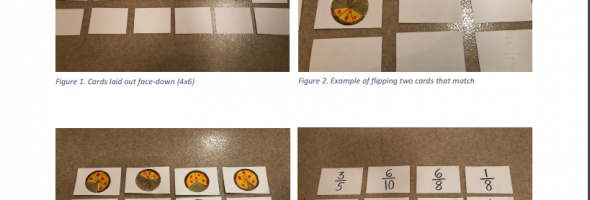Memory Matching with Fractions & Pizza Pies (Game)
Denee Nickel

Grades: 3-5
Goal: Focusing on the pizza slices missing from each pizza pie, find the matching written
fraction to each pizza pie. This game involves the use of memory to keep track of the locations
of both pizza pies and written fractions in order to make matches between the two.
Instructions:
(Refer to Appendix for visual examples of the memory cards)
1. Shuffle cards and lay them out face down in even rows (4 x 6)
2. Play a game of Memory Match – each student takes turns flipping two cards and
deciding if they match. (If two pizza pies or two written fractions are flipped, the student
must flip them back over and their opponent takes a turn.)
3. When a match is made, the student keeps the two matching cards and gets an
additional turn.
4. Play until all the cards are gone. Review and count your matches at the end.
My inspiration for this memory match game came from working with 3rd graders during
my weekly observations last semester. One thing I noted while helping these students with
math was that a lot of students benefited from a visual explanation or activity. This inspired me
to think up an activity that had the following qualities: a visual element, an element of
relevancy to the students’ lives, and of course a fun element to keep the students engaged. I
decided to look further into the 3rd grade math curriculum for inspiration and discovered that
they are introduced to fractions at this age. I remember this being somewhat of a difficult
concept to grasp at a young age, especially when solely seeing fractions written out on the
board or worksheets. This caused me to think of situations where the students might encounter
fractions in their everyday lives and I realized that food is divided up into fractions quite often –
like slices of cake or pizza! I think many children like pizza at this age and they are quite
concerned about fairness in terms of sharing things like delicious food, so I decided to
incorporate pizza pies into my fraction game. I was inspired to do a memory match game
because it can be played with 2+ players, so it involves interacting with peers and learning
together. It is also a fun way to help students in making connections between visual and written
fractions. The hope is that the more the students play, the faster they become at making the
connection between visual and written fractions, thus increasing their fraction fluency. They
also have the option of keeping themselves challenged by trying out the variations and
extensions I have listed further below.
Although this game could be played by students within the range of grades 3 to 5, it focuses on
the following aspects of the 3rd grade math curriculum:
Big Idea:
o Fractions are a type of number that can represent quantities
Curricular content:
o Fraction concepts
Curricular competencies:
o Develop, demonstrate, and apply mathematical understanding through play,
inquiry, and problem solving
o Visualize to explore mathematical concepts
Special features that were included to increase educational utility:
– If I had the materials, I would incorporate braille and make the pizzas textured in a way
that would make the game accessible to the visually impaired
– As mentioned above, I made use of an item that is relevant to the student’s lives so they
are inspired to see fractions in everyday objects (could also use layers in a cake, slices of
cake, splitting a cookie, etc.)
Variations/Extensions:
o Play with half the amount of fractions and pizzas for less of a challenge.
o Play with only the pizza pies and match the equivalent pizza fractions.
o Play with only the written fractions and match the equivalent fractions.
o Students brainstorm additional fractions that are equivalent to those displayed
on the cards.
o Students think up written fractions for how many pizza slices are left in each
pizza pie.
Assessment:
This game is simply for practice and formative assessment. It could be used during the
exploration segment of a lesson or it might appear on a “Math Menu.” If I wanted to assess the
students in a formative way, I might have them count their matches at the end of the game and
compare them to an answer sheet to ensure they are getting them correct. This would be solely
for the students to see if they’re improving each time they play – a sort of self-assessment. As a
teacher, I might observe as they play and take note of any improvements or concerns, but the
activity itself would not be formally evaluated.

